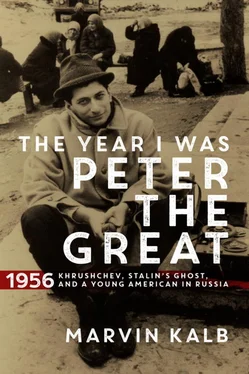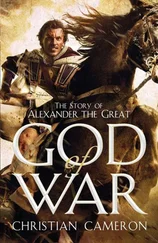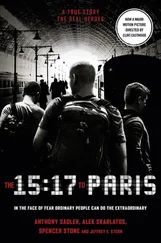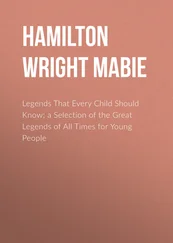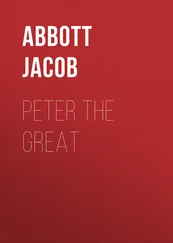As I left, I heard students mumbling, “What sort of answers is he giving us?” “What a waste of time!” “We can read the papers anytime.” “It’s time for the truth.”
That evening I noted in my diary that although I had been witness to other outbursts of student skepticism about the party line, never before had I seen “such an astonishing exposition of cynicism and disbelief.” Communism would never be built on their skeptical shoulders.
* * *
Throughout the historic summer of 1956, Khrushchev saw evidence of a fraying empire. With workers’ demands for “bread and freedom,” Poland had gone into open rebellion, and Khrushchev came close to crushing it with the Red Army. But at the last second he changed his mind, deciding instead on a political option that he hoped would calm the troubled waters of his Eastern European empire. Reluctantly he allowed the once-discredited Gomulka to return to power, even though Gomulka, with his brazen call for a “Polish way to socialism,” still represented a mortal challenge to Soviet dominance.
Yet if Poland was a crisis that for the moment seemed contained, Hungary was a crisis that was boiling, and the subject was on everyone’s mind, especially Khrushchev’s. He understood that while Stalin lived, little Stalins ruled his Eastern European empire, fearful but powerful puppets totally subjugated to the whims and temper of the man in the Kremlin. Only one communist had dared to defy Stalin, Tito of Yugoslavia, and he had paid the ultimate price in the currency of communism at that time: expulsion from Stalin’s privileged fraternity. Only once had a communist-controlled country rebelled—East Germany, in 1953—and that rebellion had been brutally crushed.
Now Khrushchev faced a new and frightening reality in Eastern Europe, and it was of his own doing. De-Stalinization, his pet initiative, had launched “the year of the thaw,” and it opened new worlds of hope and opportunity not only for the people of the Soviet Union but also for the people of Eastern Europe. They wanted a better life, a free press, a parliament with genuine debate, and they wanted a form of independence similar to Tito’s “national communism,” meaning a genuine loosening of satellite subservience to Moscow. Tito’s example was crucial: when Khrushchev began to improve relations with Tito—inviting him in June to a twenty-one-day visit to the Soviet Union and greeting him with full pomp and ceremony, like a founding father of communism returning to the fold—other East European leaders, such as Poland’s Gomulka, thought they could follow Tito’s example with impunity.
Over the summer, while traveling, I could see examples of Khrushchev backtracking on de-Stalinization at home. His daughter, Rada, said that her father “increasingly sought to limit the boundaries of critical analysis, lest it end up polarizing society.” But he could not “limit the boundaries” of excitement then sweeping through Eastern Europe, although he tried. The potential for positive change was in the air. People could breathe its intoxicating power. Fear, the normal human response to living in a totalitarian society, began magically to vanish. It was a time for action, not words. Hungary overnight became the stage for what the Soviets would later denounce as a “putsch… by fascist, counterrevolutionary forces,” the very same forces hailed in the West as freedom fighters. Russian students told me that when they saw the word “putsch” in a Pravda editorial, they knew for certain that an anti-Soviet rebellion was under way. They demanded to know the truth about what was going on in Hungary, and they knew they were not getting it. Khrushchev had profoundly misjudged the impact of de-Stalinization on Russia’s satellite empire. His reaction was late, confused, and ultimately self-destructive. For months he had hoped a political solution could be found, even if that meant he would open much of Eastern Europe to Tito’s “national communism,” but in early November, after much hesitation and self-doubt, he looked in the mirror one morning and saw only one option—no matter the cost, he felt he had to crush the uprising in Hungary, just as Russia had crushed the uprising in East Germany in 1953. Khrushchev had gambled with de-Stalinization and lost. Unfortunately, Hungary would lose, too.
The summertime run-up to the Hungarian crisis started after the Poznan uprising with purges in Hungary’s ruling elite. Matyas Rakosi, one of the “little Stalins” running Eastern Europe, was arbitrarily dismissed on July 18 and replaced by a faithful understudy, Erno Gero, who promised better days but at the same time warned that in Hungary there would be no “second Poznan.” His program might have been drafted by Khrushchev himself. It included:
Reconciliation with Tito
The end of Rakosi’s “personality cult”
The start of “collective leadership”
The abolition of terror in government
Freedom for Janos Kadar, a former senior official, jailed three years earlier, ironically, for “Titoism”
Several weeks later Gero welcomed Imre Nagy, another former senior official, back into the Communist Party. He had been accused of “rightwing deviationism,” whatever that meant at the time. Gero, under heavy pressure to reform his country, also opened parliament to political debate, unimaginable until then, and allowed Catholic priests to return to their parishes in Hungary. Many priests had fled the country to avoid religious persecution.
Meanwhile, in late September, Khrushchev and Tito exchanged visits—not, as it turned out, because they enjoyed each other’s company, but rather because they were trying to divide up Eastern Europe into a Titoesque sphere of influence and a Soviet sphere of influence. It was a cockeyed idea, probably Khrushchev’s, and it had little chance of success. But in Moscow it was a serious topic of conversation, mostly among those Western diplomats and journalists who felt Khrushchev might be losing power to hard-liners. Theoretically the Tito scenario would have allowed Khrushchev to retain personal power and keep all of Eastern Europe in communist hands as it grappled with Western capitalism (read the United States and NATO) for control of the rest of the world. According to one report of the plan, Tito would acquire ideological control over Romania and Bulgaria while Moscow would solidify its control over Poland, Hungary, Czechoslovakia, and East Germany. Also, as part of the deal Moscow would loosen its financial grip over all of Eastern Europe, theoretically stimulating economic growth and trade. On September 30 Gero joined Khrushchev and Tito in Yalta, thus adding the weight of his opinions as a communist leader eager for reform but determined to keep his country in the communist bloc.
On October 23 the lid blew. Thrilled by Gomulka’s ascension to power in neighboring Poland, several hundred thousand Hungarian students and workers took to the streets in Budapest in a massive show of solidarity with Gomulka and his Polish colleagues. Many marched on parliament to hear Nagy lay out his reform plans. Others demonstrated in front of Budapest Radio, demanding a Tito-style “national communism.” Still others converged on the hulking, thirty-foot-tall statue of Stalin in a central square and, in their rage, tore it down. “This we swear,” the rebels sang, chanting the words of a patriotic poem, “this we swear, that we will no longer be slaves.” Later that evening, Hungarian security forces opened fire on the crowd in front of the offices of Budapest Radio, killing one, wounding many others, and igniting a clash between the demonstrators and the police that ended with many of the police switching sides and joining the demonstrators. They probably didn’t know it at the time, but they had just started a revolution that would send shivers through the Kremlin and, for this reason, among others, send tens of thousands of Russian troops and tanks into Hungary in an effort to crush it.
Читать дальше
